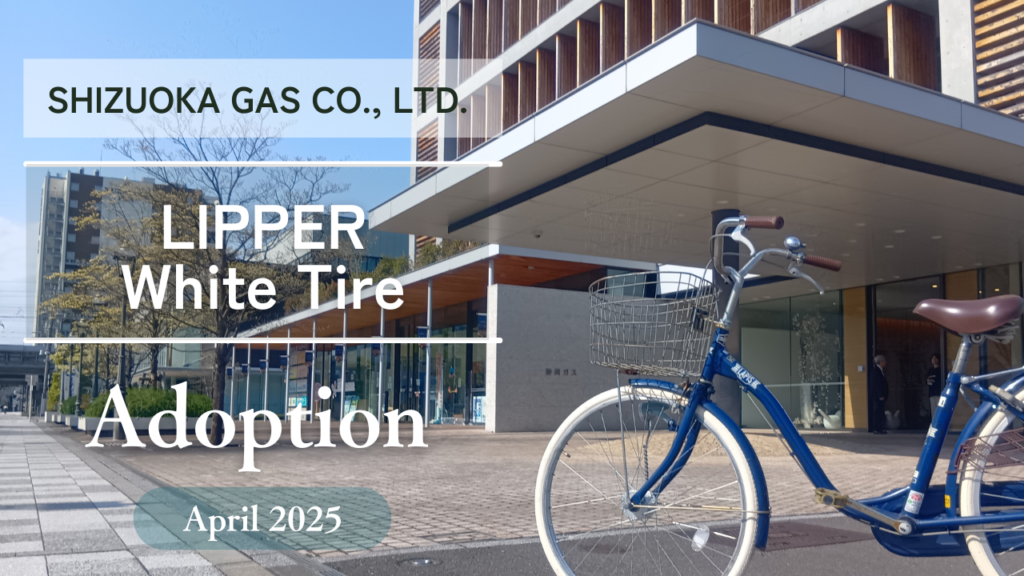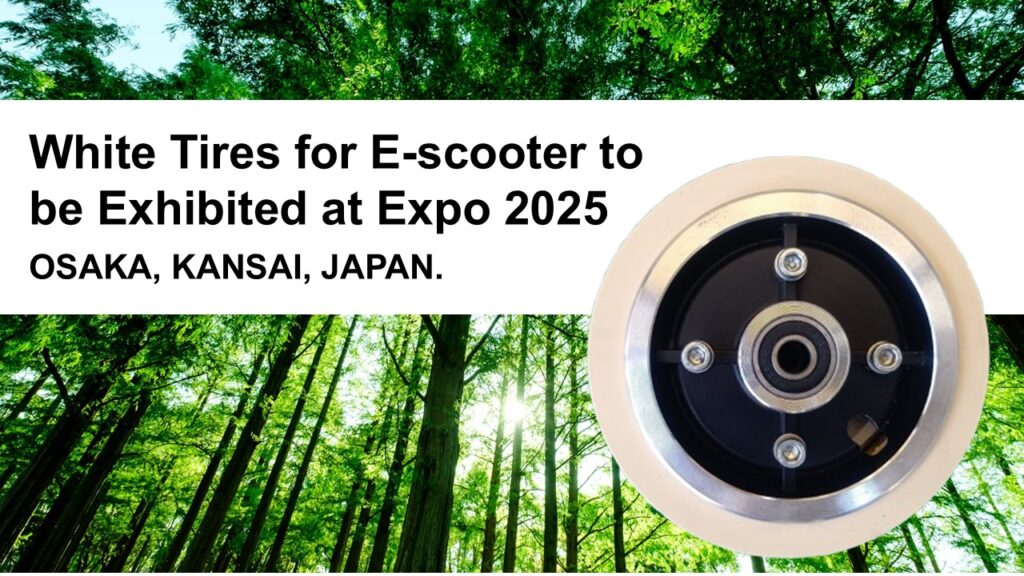Measuring the Carbon Footprint of Environmental Tires Across Their Life Cycle (LCA)
2025-09-03

We have calculated the life cycle CO₂ emissions of the environmental tires developed by LIPPER K.K. This report highlights our efforts to reduce environmental impact throughout the entire life cycle, from manufacturing and use to disposal.
I. Introduction
This document discloses the results of converting the amount of greenhouse gas (GHG) emitted over the entire life cycle of a Environmental tire developed by LIPPER K.K. into CO2 in accordance with the “LCCO2 Calculation Guidelines for Tires” (see (1)) published by the Japan Automobile Tire Association, together with the calculation method. As in reference (1), some factors used in the calculation and GHG emissions are not disclosed.
II. Approach to LCCO2 Calculation
Baseline Flow and Functional Units
The reference flow in this guideline is the life cycle of one tire:
PCs (passenger cars) sold in Japan
・PC Environmental tire
・PC General tires
The functional unit of these tires is the basic mobility of the tire, such as load bearing, force transmission, and rotation with little resistance. Noh and sufficient running life to wear out completely.
In this guideline, 30,000 km of PC tire is exemplified as the running life.
The scope of the life cycle to be calculated (system boundary), the assessment of the impact of the life cycle, the accuracy of the calculation, and the consistency of the standard are also based on Reference (1).
III. Calculation method at each stage (inventory analysis)
The calculation methods at each stage and calculation examples based on the representative tire are shown below.
The representative tire size was selected using the domestic sales volume data for each tire size in JATMA as of 2019, and the weight was determined based on the JATMA survey.
Method of selecting representative tire size:
As in Reference (1), we selected 195/65R15, which is closer to the average weight and has the largest number of sales.
Table 1. representative tire size
Tire category | Representative tire size |
PC | 195/65R15 |
Table 2. Weight of the representative tire
(unit: kg)
Tire category | Weight | |
PC | Environmental tire | 8.6 |
General tire | 8.6 | |
1. Raw material procurement stage
1) Composition ratio of raw materials
Examples of typical raw material composition ratios for each tire are shown in the table below. The composition ratio of Environmental tires was determined based on MHI’s research, and PC General tires were determined based on JATMA’s research.
Table 3. Typical tire material composition ratio (weight ratio) *
Material name | General tire | Environmental Tires | |
New rubber | 100 | 100 | |
Natural rubber | 39 | 30 | |
Synthetic rubber | 61 | 40 | |
LIPPER(NR100-18) | – | 30 | |
LIPPER_CNF | – | 6 | |
Carbon black | 50 | 0 | |
Process oil | 8 | 15 | |
Organic rubber chemical meter | 8 | 24 | |
Inorganic compounding agent | 7 | 56 | |
Zinc oxide | 3 | 5 | |
Titanium oxide | – | 5 | |
Sulphur | 3 | 2 | |
Silica | 1 | 44 | |
Fiber meter | 10 | 8 | |
Steel cord | 15 | 14.1 | |
Bead Wire | 8 | 9.5 | |
Total | 206 | 232.6 | |
Tire actual weight/New rubber weight ratio | 2.06 | 2.32 | |
*Set new rubber weight as 100
2) GHG emissions from raw material production
1. GHG emission factors for the production of each raw material
GHG in the production of each raw material Emission factors are shown in the table below.
Table 4. GHG emission factors for the production of tire materials
(Unit: kgCO2e/kg)
Material name | GHG emission factor | Source and basis | |
New rubber | – | – | |
| Natural rubber | 6.71×10-1 | P.W.Allen, The Malaysian Rubber Producers Research Association “Energy accounting. natural versus synthetic rubber” Rubber development vol32, no4, 1979 |
Synthetic rubber | 3.71 | Emission factors for styrene-butadiene rubber and butadiene rubber from IDEA were calculated by weighted average of the percentage of synthetic rubber shipped for tires and tubes (Japan Rubber Industry Association statistics, 2018 results). | |
LIPPER_ Natural Rubber | 1 | Results of our measurements | |
LIPPER_CNF | 2.003 | Results of our measurements | |
Carbon black | *** | JLCA Database, Carbon Black (2017) | |
Process oil | *** | IDEA, lubricating oil (including grease) *Unit conversion using JATMA survey specific gravity of 0.88 kg/L | |
Organic rubber chemical meter | *** | IDEA, Organic Rubber Chemicals | |
Inorganic compounding agent | – | – | |
| Zinc oxide | *** | IDEA, Zinc Oxide |
Titanium oxide | *** | IDEA, Titanium Oxide | |
Sulphur | *** | IDEA, recovered sulfur | |
Silica | *** | IDEA, silica gel | |
Fiber meter | 7.16 | Emission factors for IDEA polyester tire cord, nylon tire cord and rayon were calculated as weighted averages of consumption percentages (JATMA statistics, FY 2018 results). | |
Steel cord | *** | IDEA, wire rope (including stranded wire) | |
Bead Wire | *** | IDEA, wire rope (including stranded wire) | |
*IDEA: LCI Database IDEA version 2.3 (2019/12/27) IDEA Lab, National Institute of Advanced Industrial Science and Technology
2. Calculation of GHG emissions from the production of raw materials per tire
The GHG emissions from the production of raw materials per tire are given by:
(GHG emissions in the production of raw materials ((kgCO2e/piece)) =Σ {(tire weight (kg)) × (composition ratio of each raw material)× (GHG emission factor for the production of raw materials (kg-CO2e/kg))}
Table 5. GHG emissions from raw material production
(Unit: kgCO2e/piece)
Material name | General tire | Environmental tire | |
New rubber | – | ||
Natural rubber | 1.1 | 0.7 | |
Synthetic rubber | 9.4 | 5.2 | |
LIPPER_ Natural Rubber | – | 1.1 | |
LIPPER_CNF | – | 0.4 | |
Carbon black | *** | 0 | |
Process oil | *** | 0.4 | |
Organic rubber chemical meter | *** | 6.2 | |
Inorganic compounding agent | – | ||
Zinc oxide | *** | 0.5 | |
Titanium oxide | – | 0.3 | |
Sulfur | *** | 0.001 | |
Silica | *** | 2.6 | |
Fiber meter | *** | 2.0 | |
Steel cord | *** | 1.6 | |
Bead Wire | *** | 1.1 | |
Total | *** | 21.9 | |
3) GHG emissions from transportation of raw materials
1) Setting for transportation of raw materials
In the transportation of raw materials, the distances shown in the table below are specified.
Table 6. Setting Up Material Transportation Scenarios
Material name | Transpor distance | Remarks |
Natural rubber
| Land transport before shipping: 500 km International shipping: Goods shall arrive in Japan from the country of origin (Southeast Asian countries) via Singapore (1st hub), Shanghai, etc. (2nd hub). Land transport after shipping: 500 km
| ・Transport before and after international shipping shall be 500 km one-way by 10 ton truck with a loading rate of 50%. (As transportation between prefectures, the distance between Tokyo and Osaka is assumed.) ・International shipping feeder ships shall be 2,000TEU and this ship shall be 10,000TEU or more. (JATMA survey results, 2019) |
Synthetic rubber | Land transport 500 km
| ・Tokyo – Osaka distance assumed ・Transport: 10 ton truck, load factor Set at 50%. |
Carbon black | ||
Process oil | ||
Organic rubber chemical meter | ||
Zinc oxide | ||
Sulfur | ||
Silica | ||
Fiber meter | ||
Dteel cord | ||
Bead Wire |
Table 7. GHG Emission Factors for Transportation of Raw Materials
(Unit: kgCO2e/kg)
Material name | GHG emission factor | Remarks |
Natural rubber | 2.97×10-1 | JATMA Survey Results (2019) ・HMS surveyed GHG emissions from 18 major shipping routes ・Land transportation is calculated by fuel consumption ×GHG emission factor/loaded weight Fuel consumption calculation formula: based on the Act on the Rational Use of Energy (Energy Conservation Act) ln x=2.71-0.812 ln (y/100)-0.654 ln z x: fuel consumption per freight (l/ton-km) y: loading rate (%) z: maximum cargo capacity of truck (kg) GHG emission factor of diesel :***kgCO2e/l (IDEA, combustion energy of diesel oil) |
Synthetic rubber | *** | Calculated by the above ground transportation method |
LIPPER Natural Rubber | *** | |
LIPPER_CNF | *** | |
Carbon black | *** | |
Process oil | *** | |
Organic rubber chemical meter | *** | |
Zinc oxide | *** | |
Titanium oxide | *** | |
sulfur | *** | |
Silica | *** | |
Fiber meter | *** | |
Steel cord | *** | |
Bead Wire | *** |
2) Formula for calculating GHG emissions from the transport of raw materials per tire
The GHG emissions from the transport of raw materials per tire are given by:
(GHG emissions from transportation of raw materials (kgCO2e/unit))
=Σ {(tire weight (kg)) × (composition ratio of each raw material) ×(GHG emission factor for transport of raw materials (kgCO2e/kg))
Table 8. GHG emissions from transportation of raw materials
(Unit: kgCO2e/piece)
Material name | General Tire | Environmental tire | |
New rubber | – | – | |
Natural rubber | 0.48 | 0.31 | |
Synthetic rubber | *** | 0.13 | |
LIPPER_ Natural Rubber | *** | 0.1 | |
LIPPER_CNF | *** | 0.02 | |
Carbon black | *** | 0 | |
Process oil | *** | 0.05 | |
Organic rubber chemical meter | *** | 0.08 | |
Inorganic compounding agent | *** | – | |
Zinc oxide | *** | 0.02 | |
Titanium oxide | – | 0.02 | |
Sulphur | *** | 0.01 | |
Silica | *** | 0.15 | |
Fiber meter | *** | 0.03 | |
Steel cord | *** | 0.05 | |
Bead Wire | *** | 0.03 | |
Total | 1.15 | 1.00 | |
4) GHG emissions at the entire raw material procurement stage
GHG at the entire raw material procurement stage Emissions are shown in the table below. (GHG emissions at the entire raw material procurement stage)
= (GHG emissions from the production of raw materials) + (GHG emissions from the transport of raw materials)
Table 9. GHG emissions at the entire raw material procurement stage
(Unit: kgCO2e/piece)
PC | |||
Category | General tire | Environmental tire | |
Raw material procurement stage | Raw material production | 26.3 | 21.9 |
Raw material transportation | 1.1 | 1 | |
Total | 27.4 | 22.9 | |
2. Production and distribution stages
As our Environmental tire is currently under development, it is not possible to accurately calculate GHG emissions at the production and distribution stages, so we use the results of the PC fuel-efficient tire (see (1) for a detailed calculation method).
3. Stage of use
For the tire use stage, the contribution of tires to the GHG emissions emitted as the tires are fitted to the vehicle and the vehicle is driven is allocated and calculated.
1) Setting of tire operating conditions
The tire operating conditions for which GHG emissions are calculated are shown in Table 10.
For these representative tire sizes, RRC Values are examples only, not market averages.
Table 10. Establishment of tire use conditions to calculate GHG emissions
Category | PC | Unit | Remarks | |
General Tire | Environmental tire | |||
Tire Size | 195/65R15 | |||
Tire rolling resistance coefficient (RRC) | 10.5 | 9.5 | JATMA selection * | |
(Tire Rolling Resistance Index) | 100 | 90 | % | General Tire=100 |
Vehicle fuel economy | 15.25 | 16.3 | km/l | JATMA survey result |
0.0656 | 0.062 | l/km | ||
Fuel consumption contribution of tires | 0.179 | 0.17 | ||
Vehicle Fuel | Gasoline | – | ||
Number of mounted tires | 4 | piece | ||
Tire running life | 30,000 | JATMA survey result | ||
*Based on the Report on the Investigation and Analysis of Tire Usage Period (the Ministry of the Environment, 2016, 2017.) and the Report on the Japan Greenhouse Gas Inventory (Center for Global Environmental Research, National Institute for Environmental Studies, 2020).
Using the fuel economy (0.0538 l/km) caused by factors other than the tire rolling resistance calculated in Reference (1), the vehicle fuel economy and the contribution of the tire fuel economy assuming that a PC Environmental tire with RRC=9.45 is installed are calculated as follows.
Fuel economy of a vehicle equipped with PC Environmental tires = Fuel economy attributable to tire rolling resistance + Fuel economy attributable to resistance other than tire rolling resistance
= 0.0027 ÷ 2.4 x 9.45 + 0.0538
= 0.0644 (l/km)
Fuel consumption contribution ratio of PC Environmental tires = fuel consumption attributable to tire rolling resistance ÷ vehicle fuel consumption
= 0.0027 / 2.4 x 9.45 / 0.0644
= 0.165
2) GHG emissions at the use stage
1. GHG emission factors for vehicle fuels
Table 11. GHG emission factors for vehicle fuels
(Unit: kgCO2e/l)
Category | GHG emission factor | Source |
Gasoline | 2.84 | IDEA, gasoline combustion energy |
Diesel oil | 2.99 | IDEA, combustion energy of diesel oil |
2. Tire-induced fuel consumption (l/km) and GHG emissions
The fuel consumption (l/km) and GHG emissions attributable to tires are given by: (Tire-induced fuel consumption (l/km))
= (fuel consumption per kilometre per tire (l/km)) x (tire running life)
= (vehicle fuel consumption) × (contribution ratio of tire fuel consumption) ÷ (number of tires) × (tire running life)
(tire-induced GHG emissions) = (tire-induced fuel consumption (l/km)) x (vehicle fuel GHG emission factor)
Table 12. Fuel consumption (l/km) and GHG emissions from tires
Category | PC | Unit | |
General Tire | Environmental tire | ||
Tire-induced fuel consumption per kilometre per tire (l/km) | *** | 2.65×10-3 | l/km/book |
Tire-induced fuel consumption (l/km)(per tire life) | *** | 79.7 | l/piece |
GHG emissions from tires (per tire life) | 250.5 | 226.4 | kgCO2e/piece |
4. Disposal and recycling stages
Calculate GHG emissions at the disposal and recycling stage.
1)GHG emissions from the transport of used tires
1. Setting conditions for the transport of used Tires
The GHG emissions of the transport of used Tires are calculated under the conditions set out in Table 13.
Table 13. Setting conditions for the transport of used Tires
Category | Content | Remarks |
Subject | Transport of used tires from sites (dealers, etc.) to waste treatment facilities | – |
Transport distance | 100 km one-way transport | As transportation within the prefecture, the distance between prefectural borders is assumed. |
Means of transportation | two-ton truck | JATMA settings |
Loading ratio | 50% | JATMA settings |
Fuel economy formula | Compliant with the Act on the Rational Use of Energy (Energy Conservation Act) | ln x=2.71-0.812 ln (y/100)-0.654 ln z x: fuel consumption per freight (l/ton-km) y: loading rate (%) z: maximum laden capacity of the truck (kg) |
GHG emission factor for diesel oil | ***kgCO2e/l | IDEA, combustion energy of diesel oil |
Used GHG of Tire transport emission factor | 0.0547kgCO2e/kg | Fuel consumption x GHG emission factor/loaded weight |
2. GHG emissions from used tire transport
The transport GHG emissions per used tire are given by: (GHG emissions from transport of used Tires)
= (weight of used tires) x (GHG emission factor for transport of used tires)
Table 14. Transport GHG emissions per used tire
Category | PC | Unit | ||
General tire | Environmental tire | |||
New Tire weight (a) | 8.6 | 8.2 | kg | From Table 2 |
Abrasion rate (b) | 15 | % | * | |
Weight of used Tires (a) x (1-b) | 7.3 | 7 | kg | |
GHG emission factors for transport of used Tires (c) | 0.0547 | kgCO2e/kg | From Table 13 | |
GHG emissions from used Tire transport | 0.4 | 0.38 | kgCO2e/piece | |
(a)x(1-b)×(c) | ||||
* Weight loss% for total wear is set based on calculation of tire specifications, etc.
2) GHG Emissions and Emission Reduction Effects of Heat Use
1. GHG emissions from heat use
a) Carbon content in new tires
The carbon content of the tire is determined from the tire raw material composition ratio and the carbon content ratio of each raw material. Renewable materials (natural rubber) were excluded from the carbon content because they were regarded as carbon-neutral materials.
In addition, for heat utilization of used tires, a process for cutting the tires may be required. It was excluded because the emissions were very small (about 1/1,000) compared to tire combustion.
Table 15. Carbon content in new tires *1
Material name | Carbon content (considering carbon neutrality) | Carbon content ratio | Carbon neutral *3 | ||
PC | *2 | ||||
General tire | Environmental tire | ||||
New rubber | – | – | – | – | |
Natural rubber | 0 | 0 | 0.88 | 0 | |
Synthetic rubber | 54.3 | 35.6 | 0.89 | 1 | |
LIPPER_ Natural Rubber | 0 | 0 | |||
LIPPER_CNF | 0 | 0 | |||
Carbon black | 49 | 0 | 0.98 | 1 | |
Process oil | 6.7 | 12.6 | 0.84 | 1 | |
Organic rubber chemical meter *4 | 5.4 | 16.8 | 0.67 | 1 | |
Inorganic compounding agent | – | – | – | N | |
Zinc oxide | 0 | 0 | 0 | N | |
Titanium oxide | – | 0 | 0 | N | |
Sulphur | 0 | 0 | 0 | N | |
Silica | 0 | 0 | 0 | N | |
Fiber meter | 6.2 | 5 | 0.62 | 1 | |
Steel cord | 0 | 0 | 0 | N | |
Bead Wire | 0 | 0 | 0 | N | |
Total | 121.6 | 69.2 | – | – | |
Carbon content in tires * 5 | 0.59 | 0.3 | – | – | |
*1: Weight index when the weight of new rubber is 100. Calculated by multiplying the raw material composition ratio in Table 3 by the carbon content ratio
*2: The carbon content ratio of each raw material is estimated by JATMA based on the basic molecular structure.
*3: carbon neutral =0, not carbon neutral =1, raw material without carbon content =N
*4: Organic rubber drugs were calculated from the basic molecular structures of typical vulcanization accelerators and anti-aging agents.
*5: Calculated by dividing the carbon content meter in this table by the total weight index (206.0 in the case of PC general tires) when the weight of new rubber in Table 3 is 100.
b) Changes in material constituents and carbon content after tire wear
Since tire wear consists only of rubber components, the weight of the total component weight minus the weight of the fiber gauge, steel cord and bead wire was subtracted proportionally.
Table 16. Change in carbon content due to wear loss
Category | PC | Remarks | ||
General tire | Environmental tire | |||
New tire | Composed weight (a) | 206 | 232.6 | *1 |
Weight of wear components (b) | 173 | 231 | *2 | |
Carbon content (c) | 121.6 | 69.24 | Calculated in Table 15 | |
Carbon content (d) | 59.00% | 29.80% | ||
Used tire | Composed weight (e) | 175.1 | 197.7 | (a)x (1- Abrasion rate) *3 |
Weight of wear components (f) | 142.1 | 196.1 | (b)-(a-e) | |
Carbon content (g) | 101 | 59.5 | *4 | |
carbon content | 57.70% | 30.10% | (g)/(e) | |
*1. Table 3: Weight index with new rubber content of 100
*2 Component weight (a) minus fiber meter, steel cord and bead wire (rubber compound weight index)
*3 As described in Table 14
*4. Carbon content meter of new wear components (Total for natural rubber, synthetic rubber, carbon black, process oil, and organic rubber drugs in Table 15) x ((f) ÷ (b)) + carbon content of new steel cord, bead wire and fiber meter
c) GHG emissions per kilogram of used tires burned
The GHG emissions per kilogram of Tire during the combustion of used Tires are given by the following equation: (GHG emissions per kg of Tire from used Tire combustion)
= (carbon content of used Tires) × 44 ÷12
Table 17. GHG emissions per kilogram of used tires burned
Category | General Tire | Environmental tire | |
Carbon content of used Tires (from Table 16) | 57.7 | 30.1 | % |
GHG emissions per kilogram of used tires burned | 2.114 | 1.104 | kgCO2e/kg |
d) GHG emissions per tire when used tires are burned
The GHG emissions per tire during the combustion of used tires are determined by the following equation: (GHG emissions per Tire from used Tire combustion)
= (GHG emissions per kilogram of Tire from used Tire combustion)
x (used Tire weight)
Table 18. GHG emissions per tire when used tires are burned
Category | General Tire | Environmental tire | Remarks |
GHG emissions per kilogram of used tires burned | 2.114 | 1.104 | kgCO2e/kg |
Weight of used tires | 7.3 | 7.0 | kg |
GHG emissions per tire when used tires are burned | 15.5 | 7.7 | kgCO2e/piece |
2. GHG Emission Reduction Effects of Heat Use
By using used tires as a heat source to recover energy, it can be assumed that fossil fuel consumption is replaced and GHG emissions are reduced, and the reduction effect is calculated.
a) Fossil fuel substitutes for heat from used tires
The paper industry is cited as the main heat application of used tires. As a result of the hearing with the paper manufacturers, used tires are mainly used instead of C heavy oil. Therefore, it is assumed that the used tires have replaced C heavy oil.
b) GHG emission reduction effect of heat utilization of used tires
GHG from heat utilization of used tires The emission reduction effect is calculated by the following equation.
(Effect of reducing GHG emissions from heat use of used tires)=
(GHG emission factor of C heavy oil) x (calorific value of tire) x (weight of used tire)
Table 19. GHG emission reduction effect of heat utilization of used tires
Category | PC | Unit | Remarks | |
General tire | Environmental tire | |||
GHG emission factor for C heavy oil | *** | kgCO2e/MJ | *1 | |
calorific value of the tire | *** | MJ/kg | *2 | |
Weight of used tires | 7.3 | 7 | kg | From Table 14 |
GHG reduction effect | -20.4 | -19.4 | kgCO2e/piece | |
*1 Combustion energy of IDEA C heavy oil
*2. Higher calorific value of IDEA waste tires
c) GHG emissions from heat use (total)
GHG in heat use Emissions (total) are calculated by the following formula:
For the aggregated results, see “Table 20. GHG Emissions and Emission Reduction Effects at the Disposal and Recycling Stage.” (GHG emissions from heat use)
= (GHG emissions from the transport of used Tires)
+ (GHG emissions per Tire from used Tire combustion)
– (GHG emission reduction benefits from heat use of used tires)
3) GHG Emissions and Emission Reduction Effects at the Disposal and Recycling Stage
GHG Emissions and Emission Reduction Effects at the Disposal and Recycling Stage
The GHG emissions for each recycling method were weighted by the recycling ratio (78% heat use), and the GHG emissions at the disposal stage and the emission reduction effect of recycling were shown in the table below.
Table 20. GHG Emissions and Emission Reduction Effects at the Disposal and Recycling Stage
(Unit: kgCO2e/piece)
Category | PC | Remarks | ||
General tire | Environmental tire | |||
Recycling ratio | Heat utilization | 78% | Figure 4 | |
Other than recycling | 22% | |||
GHG Emissions | Transportation | 0.4 | 0.4 | TABLE 26 |
Heat utilization | 12.1 | 6 | GHG emissions in Table 30 | |
× Ratio of heat use | ||||
Simple incineration | 3.4 | 1.7 | GHG emissions in Table 30 | |
× Ratio other than recycling | ||||
Emission reduction effect | Heat utilization | -15.9 | -15.2 | GHG emission reductions x heat share in Table 31 |
5. Life-Cycle GHG emissions
Life-Cycle GHG based on representative Tires Total emissions are shown below.
Table 21. Lifecycle GHG Emissions (Details)
(Unit: kgCO2e/piece)
Category | General Tire | Environmental tire | ||
Procurement of raw materials stage | Raw material production | 26.3 | 21.9 | |
Raw material transportation | 1.1 | 1.00 | ||
Production stage | Production | 6.9 | 6.6 | |
Distribution stage | Transportation | 0.9 | 0.9 | |
Stage of use | Use | 250.5 | 226.4 | |
Disposal and recycling stage | Emissions | Transportation | 0.4 | 0.4 |
Heat utilization | 12.1 | 6.0 | ||
Simple incineration | 3.4 | 1.69 | ||
Total GHG emissions | 301.5 | 264.9 | ||
Disposal and recycling stage | Reduction effect | Heat utilization | -15.9 | -15.2 |
Life-cycle GHG emissions (including reduction effects) | 285.6 | 249.7 | ||
Table 22 Life-Cycle GHG Emissions by Stage
(Unit: kgCO2e/piece)
Category | General tire | Environmental tire | |||
Raw material procurement stage | 27.4 | 9.60% | 22.9 | 8.99% | |
Production stage | 6.9 | 2.40% | 6.6 | 2.59% | |
Distribution stage | 0.9 | 0.30% | 0.9 | 0.33% | |
Stage of use | 250.5 | 87.70% | 226.45 | 88.90% | |
Disposal and recycling stages | 0 | 0.00% | -2.2 | -0.86% | |
Discharge | 15.9 | 5.60% | 13 | 5.11% | |
Emission reduction effect | -15.9 | -5.60% | -15.2 | -5.95% | |
Total | 285.6 | 100.00% | 254.6 | 100.00% | |
Life Cycle GHG Emissions per Tire (kg CO₂e)
Life Cycle GHG Emissions per Tire (table)
- Passenger Car General Tire — Life Cycle GHG Emissions per Tire = 285.6 kg CO₂e
- Passenger Car Environmental Tire — Life Cycle GHG Emissions per Tire = 212.0 kg CO₂e
Raw material procurement stage | Production | Distribution | Stage of Use | Disposal and recycling stages | |
Passenger Car General Tire | 27.4kgCO2e 9.6% | 6.9kgCO2e 2.4% | 0.9kgCO2e 0.3% | 250.5kgCO2e 87.7% | 0.0kgCO2e 0.0% |
Note: GHG emissions at the disposal/recycling stage — Emissions = 15.9 kg CO₂e, Reduction effect = –15.9 kg CO₂e | |||||
Passenger Car Environmental tire | 22.9kgCO2e 8.99% | 6.6kgCO2e 2.59% | 0.9kgCO2e 0.33% | 188.7kgCO2e 89.0% | -2.2kgCO2e -0.86% |
Note: GHG emissions at the disposal/recycling stage — Emissions = 13.0 kg CO₂e, Reduction effect = –15.1 kg CO₂e | |||||
In this article, the life of each tire is considered to be the same, and the evaluation per tire is conducted.
A comparison on a per Tire basis is not appropriate when comparing Tires. In this case, for example, comparison per unit distance can be considered. In this case, as shown in this document, LCCO2 can be calculated for each tire with a different running life, and then converted into emissions per unit running distance for relative comparison.
GHG emissions per unit mileage = tire LCCO2 x unit mileage / mileage
6. References
- LCCO2 Calculation Guidelines for Tires (Japan Automobile Tire Association)
- JATMA Labeling System: https://www.jatma.or.jp/environment_recycle/aboutlabelingsystem.html
Share the article









